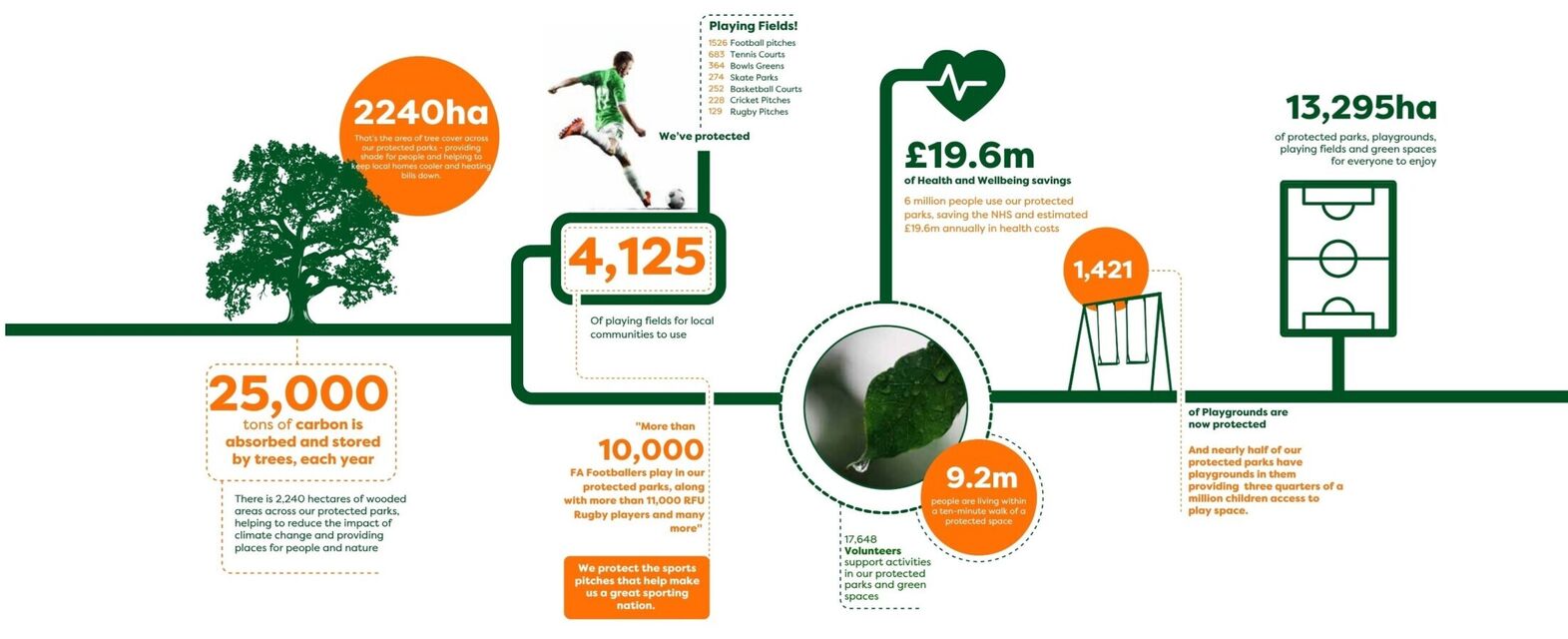Our Impact
Over the last hundred years our approach to protecting spaces for future generations has continuously evolved. We’re proud of what we’ve achieved during that time creating an incredible legacy of 3,000 protected spaces and directly influencing the creation of thousands more.
For over a century, Fields in Trust has safeguarded more than 3,000 parks across the UK, creating a national green infrastructure that delivers measurable benefits for climate, public health, and community wellbeing. This study, the most comprehensive geospatial and environmental analysis to date, highlights how these protected spaces aren't just scenic—they're silently working to cool our cities, clean our air, and connect millions of people to nature.
Cooling Cities: As climate change intensifies, urban heat becomes a major threat to public health. Parks over half a hectare cool their surroundings by an average of 130–1,300 metres depending on size, affecting over 1.9 million people across 75,000 hectares—an area larger than Greater Manchester.
Sequestering Carbon: The trees and woodlands in FIT parks store and absorb tens of thousands of tonnes of carbon dioxide every year—up to 25,000 tonnes annually at peak estimates. Since 1925, the parks have collectively absorbed more than 360,000 tonnes of CO₂, the equivalent of powering over 44,000 homes for a year.
Protecting Health and Reducing Costs: Over 9.2 million people live within a 10-minute walk of a FIT-protected park. Of those, 6.2 million actively use them—generating an estimated £6 billion per year in wellbeing value and saving the NHS £19.6 million annually by promoting physical activity and reducing stress-related conditions.
Natural Water Management: FIT parks naturally intercept and evaporate stormwater—over 653 million litres annually, equivalent to 261 Olympic swimming pools—providing £3.7 million in avoided drainage costs.
Air Quality Benefits: The tree cover across these parks filters harmful pollutants such as PM2.5 and NO₂, contributing to public health and saving millions more in damage costs each year. Trees remove over 230 tonnes of key pollutants annually, including particulates that are linked to thousands of premature deaths across the UK.
Long-Term Legacy: Since 1931, the population living near protected parks has grown from 49,000 to over 11 million today, demonstrating their enduring social value. As urbanisation continues, these parks form a crucial backbone in creating healthy, resilient, and inclusive communities.
Protecting parks therefore isn't just about green space—it's about measurable, long-lasting, and wide-reaching public benefit. With climate pressures rising and urban populations growing, the case for safeguarding even more green space is stronger than ever.
But parks are more than numbers—they’re stories of communities, memories, and resilience. Behind every hectare of cooling canopy or tonne of carbon stored is a place where children play, neighbours connect, and traditions continue. Protected parks have hosted family picnics, grassroots sports, and quiet moments of reflection for generations. Their true value is not just in the data we measure, but in the everyday lives they quietly enrich.
Below, you can find a few case studies that bring these stories to life.
